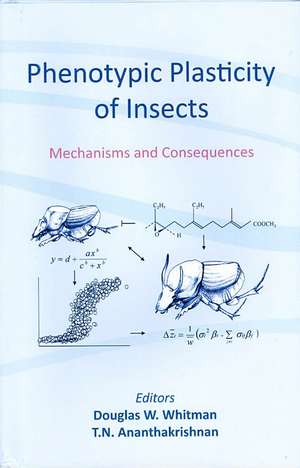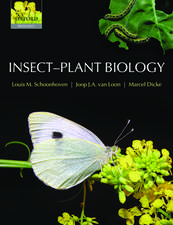Phenotypic Plasticity of Insects: Mechanisms and Consequences
Editat de Douglas Whitmanen Limba Engleză Hardback – 2009
Preț: 1376.57 lei
Preț vechi: 1678.74 lei
-18% Nou
Puncte Express: 2065
Preț estimativ în valută:
263.44€ • 274.02$ • 217.48£
263.44€ • 274.02$ • 217.48£
Carte tipărită la comandă
Livrare economică 14-28 aprilie
Preluare comenzi: 021 569.72.76
Specificații
ISBN-13: 9781578084234
ISBN-10: 1578084237
Pagini: 904
Ilustrații: Illustrations
Dimensiuni: 152 x 229 x 46 mm
Greutate: 1.88 kg
Ediția:1
Editura: CRC Press
Colecția CRC Press
ISBN-10: 1578084237
Pagini: 904
Ilustrații: Illustrations
Dimensiuni: 152 x 229 x 46 mm
Greutate: 1.88 kg
Ediția:1
Editura: CRC Press
Colecția CRC Press
Cuprins
What is Phenotypic Plasticity and Why is it Important?; Phenotypic Plasticity and the Semantics of Polythenism: A Historical Review and Current Perspectives; Phenotypic Plasticity and the Origins of Diversity: A Case Study on Horned Beetles; Developmental Flexibility, Phenotypic Plasticity, and Host Plants: A Case Study with Nemoria Caterpillars; Phase Polyphenism in Locusts: Mechanisms, Population, Consequences, Adaptive Significance and Evolution; Density-Dependent Prophylaxis in Insects; Natural Enemy-Induced Plasticity in Plants and Animals; A Behaviorally Plasticity Response to Risk of Predation: Oviposition Site Selection by a Mosquito in Response to its Predators; Polyphenisms in Lepidoptera: Multidisciplinary Approaches to Studies of Evolution and Development; Causes and Consequences of Phenotypic Plasticity in Body Size: The Case of the Yellow Dung Fly Scathophaga stercoraria (Diptera: Scathophagidae; She Shapes Events as they Come: Plasticity in Female Insect Reproduction; Temperature Dependence of Development Rate, Growth Rate and Size: From Biophysics to Adaptation; The Developmental-Physiological Basis of Phenotypic Plasticity; Wing Polymorphism in Gryllus (Orthoptera: Gryllidae) Proximate Endocrine, Energetic and Biochemical Mechanisms Underlying Morph Specialization for Flight vs. Reproduction; Evolution of Homeostatic Physiological Systems; Acclimation as Adaptive Phenotypic Plasticity; Heat Shock Proteins and their Role in Generating, Maintaining and Even Preventing Alternative Insect Phenotypes; Learned Host Preferences; Adaptive Maternal Effects: A Case Study of Egg Size Plasticity in a Seed-Feeding Bettle; On the Origins of Insect Hormone Signaling; Phenotypic Plasticity and Evolvability: An Empirical Test with Experimental Evolution
Descriere
This book explores the profound importance of phenotypic plasticity as a central organizing theme for understanding biology. Chapters take a broad, integrative approach to explain how physical and biological environmental stimuli (temperature, photoperiod, nutrition, population density, predator presence, etc.), influence insect biochemical, physiological, learning, and developmental processes, altering phenotype, which then influences performance, ecology, life-history, survival, fitness, and subsequent evolution. Topics include endocrinology, development, body size, allometry, polyphenism, reproduction, reproductive and life-history tradeoffs, alternative mating and life-history strategies, density-dependent prophylaxis, physiological adaptation, acclimation, homeostasis, heat-shock proteins, learning, adaptive anti-predator behavior, and evolution of phenotypic plasticity.













